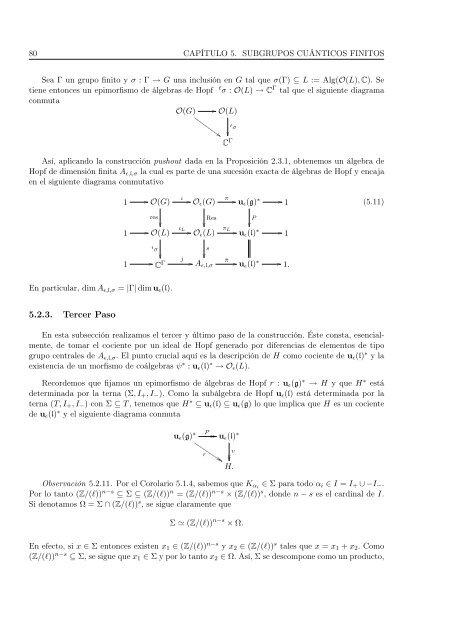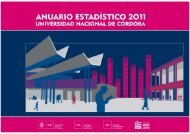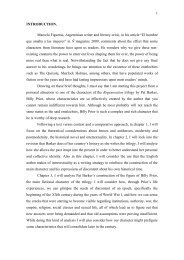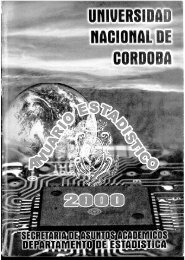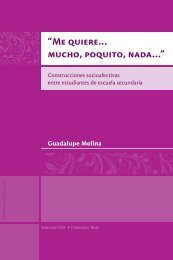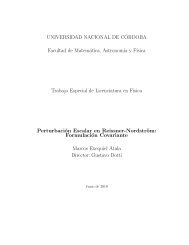Abrir - RDU - Universidad Nacional de Córdoba
Abrir - RDU - Universidad Nacional de Córdoba
Abrir - RDU - Universidad Nacional de Córdoba
You also want an ePaper? Increase the reach of your titles
YUMPU automatically turns print PDFs into web optimized ePapers that Google loves.
80 CAPÍTULO 5. SUBGRUPOS CUÁNTICOS FINITOS<br />
Sea Γ un grupo finito y σ : Γ → G una inclusión en G tal que σ(Γ) ⊆ L := Alg(O(L), C). Se<br />
tiene entonces un epimorfismo <strong>de</strong> álgebras <strong>de</strong> Hopf t σ : O(L) → C Γ tal que el siguiente diagrama<br />
conmuta<br />
O(G) O(L)<br />
<br />
Así, aplicando la construcción pushout dada en la Proposición 2.3.1, obtenemos un álgebra <strong>de</strong><br />
Hopf <strong>de</strong> dimensión finita A ɛ,l,σ la cual es parte <strong>de</strong> una sucesión exacta <strong>de</strong> álgebras <strong>de</strong> Hopf y encaja<br />
en el siguiente diagrama conmutativo<br />
t σ<br />
<br />
C Γ<br />
1 O(G)<br />
ι<br />
O ɛ (G)<br />
π<br />
u ɛ (g) ∗<br />
1<br />
(5.11)<br />
res<br />
1 O(L)<br />
ι L<br />
Res<br />
O ɛ (L)<br />
π L<br />
P<br />
u ɛ (l) ∗ 1<br />
1 <br />
t σ<br />
<br />
C Γ<br />
j<br />
s<br />
A ɛ,l,σ<br />
¯π u ɛ (l) ∗ 1.<br />
En particular, dim A ɛ,l,σ = |Γ| dim u ɛ (l).<br />
5.2.3. Tercer Paso<br />
En esta subsección realizamos el tercer y último paso <strong>de</strong> la construcción. Éste consta, esencialmente,<br />
<strong>de</strong> tomar el cociente por un i<strong>de</strong>al <strong>de</strong> Hopf generado por diferencias <strong>de</strong> elementos <strong>de</strong> tipo<br />
grupo centrales <strong>de</strong> A ɛ,l,σ . El punto crucial aquí es la <strong>de</strong>scripción <strong>de</strong> H como cociente <strong>de</strong> u ɛ (l) ∗ y la<br />
existencia <strong>de</strong> un morfismo <strong>de</strong> coálgebras ψ ∗ : u ɛ (l) ∗ → O ɛ (L).<br />
Recor<strong>de</strong>mos que fijamos un epimorfismo <strong>de</strong> álgebras <strong>de</strong> Hopf r : u ɛ (g) ∗ → H y que H ∗ está<br />
<strong>de</strong>terminada por la terna (Σ, I + , I − ). Como la subálgebra <strong>de</strong> Hopf u ɛ (l) está <strong>de</strong>terminada por la<br />
terna (T, I + , I − ) con Σ ⊆ T , tenemos que H ∗ ⊆ u ɛ (l) ⊆ u ɛ (g) lo que implica que H es un cociente<br />
<strong>de</strong> u ɛ (l) ∗ y el siguiente diagrama conmuta<br />
u ɛ (g) ∗ P u<br />
ɛ (l) ∗<br />
<br />
v<br />
r<br />
<br />
H.<br />
Observación 5.2.11. Por el Corolario 5.1.4, sabemos que K αi ∈ Σ para todo α i ∈ I = I + ∪ −I − .<br />
Por lo tanto (Z/(l)) n−s ⊆ Σ ⊆ (Z/(l)) n = (Z/(l)) n−s × (Z/(l)) s , don<strong>de</strong> n − s es el cardinal <strong>de</strong> I.<br />
Si <strong>de</strong>notamos Ω = Σ ∩ (Z/(l)) s , se sigue claramente que<br />
Σ ≃ (Z/(l)) n−s × Ω.<br />
En efecto, si x ∈ Σ entonces existen x 1 ∈ (Z/(l)) n−s y x 2 ∈ (Z/(l)) s tales que x = x 1 + x 2 . Como<br />
(Z/(l)) n−s ⊆ Σ, se sigue que x 1 ∈ Σ y por lo tanto x 2 ∈ Ω. Así, Σ se <strong>de</strong>scompone como un producto,


